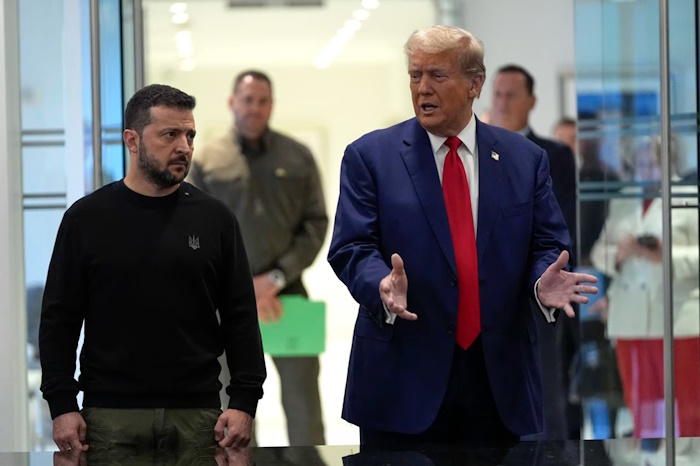
Just days after US president Donald Trump hailed a breakthrough summit with Russian president Vladimir Putin, due to take place in a few weeks, the proposed talks to end the Ukraine war have receded into an indeterminate future.
This comes after yet another phone-call between Trump and Putin last Thursday raised the prospects of a significant advance in peace negotiations, based on Ukrainian territorial concessions to Russia, only to be quashed the following day after Trump met Ukrainian president Volodymyr Zelenskyy in the White House.
This stop-go dynamic has been typical of negotiations to end the war since Trump became president in 2025. His election marked a shift in the US position, whereby Washington has sought to engage Russia, and give it concessions, in order to end the war in Ukraine. The bigger intention is to prise Russia away from China, its principal rival in an emerging multipolar order, by bringing it back into the fold.
But Trump’s turn towards negotiating with Russia is also a reflection of the fact that Russia’s position on the military front has improved. Ever since Ukraine’s failed offensive in summer 2023, Moscow’s forces have been edging forward in a gruesome war of attrition in eastern Ukraine. Ukraine’s growing manpower problem betrays its underlying weakness against its bigger neighbour.
That explains Trump’s alleged outburst last Friday in his meeting with Zelenskyy that, if Ukraine did not sign up to Putin’s peace plan, Russia would destroy Ukraine. Indeed, Trump has periodically stopped sharing intelligence with Ukraine and suspended arms shipments, attempting to push Zelenskyy towards a deal. In the latest twist, he refused to give Ukraine long-range Tomahawk missiles before taking a call from Putin.
Putin appeared to sense an opening. He made a renewed pitch for a negotiated end to the conflict, scaling down his demands from earlier this year for Ukraine to cede not just all territory currently occupied but also the rest of the unoccupied Donbas. Now, he offered to return parts of occupied territory in the front-line regions of Kherson and Zaporizhzhia in exchange for unoccupied parts of Donbas.
But Zelenskyy refused. He continues to bank on a long war against Russia in which Ukraine relies on increasing support from hawks in the West. In a typical move, Zelenskyy once again appealed to the most reactionary circles in the US and Europe by publicly likening Putin to Hamas, adding that Putin was stronger than Hamas and had to come under greater pressure to do a deal.
It is hard to imagine what he means, given the scale of the destruction of Gaza that we have been witness to since October 2023. But what is clear is that Zelenskyy continues to position himself, as he has in the past, as a reliable Western military outpost against Russia. He seeks the escalation of the war by dragging the West deeper and deeper into the conflict.
For now, Zelenskyy’s position is bolstered by European support. In an unlikely twist, with Washington increasingly favourable to a deal with Moscow, it is the so-called ‘coalition of the willing’, comprised of hawkish European capitals, often led by London, that has consistently frustrated negotiations to end the war on terms they deem too favourable to their Russian foe in the course of 2025.
European leaders rejected Trump’s apparent proposal to end the war at the current contact line, seeing it rather as the basis for a ceasefire and negotiations. As Trump then walked back his initial statements, Russia’s foreign minister Sergei Lavrov rejected the proposed immediate ceasefire on Tuesday, seemingly taking negotiations back to square one.
Duly, after Zelenskyy’s refusal, Putin sought to prove Trump’s threats of destroying Ukraine correct. Russia continued its massive aerial campaign against Ukraine’s energy infrastructure this week. According to the Financial Times, Russian strikes have by now disabled 60 percent of Ukraine’s gas production ahead of the coming winter. The costs for ordinary people are likely to be severe.
And not just in Ukraine. Both in Russia and the West, ordinary people are increasingly footing the bill. Although Russia’s economy has withstood sanctions longer than many analysts in the West predicted, sanctions appear to be biting, with a major slowdown predicted this year. Russian officials are predicting growth of just 1.5 percent in 2025, but the IMF has predicted this would be a mere 0.6 percent.
But the Western economies are not doing much better. The Eurozone area is predicted to grow just 0.9 percent this year. With increasing talk of replacing welfare states with warfare states, it is unsurprising that public war weariness is increasing across Europe too. That reflects the mood in Ukraine itself. A Gallup poll in early July found 69 percent of Ukrainians wanted a negotiated end to the war as soon as possible, while just under a quarter, 24 percent, support continuing the war until victory.
No wonder. The truth is that every time that negotiations have broken down, further rounds of escalation have occurred, causing death and destruction in their wake. Opposition to continuing the war is likely to mount in both Russia and the West, and peace movements in both should be pressing the argument that a negotiated end to the war is preferable to its brutal continuation, with the ever present danger of uncontrolled and catastrophic escalation involving nuclear powers led by erratic and unrestrained leaders.